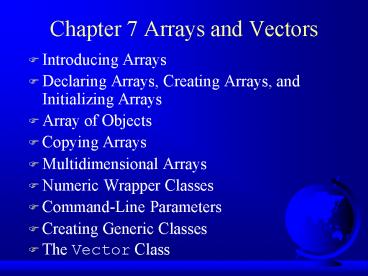Chapter 7 Arrays and Vectors - PowerPoint PPT Presentation
1 / 27
Title:
Chapter 7 Arrays and Vectors
Description:
Array is a data structure that represents a collection of the same ... Declaring, creating, initializing in one step: double[] myList = {1.9, 2.9, 3.4, 3.5} ... – PowerPoint PPT presentation
Number of Views:62
Avg rating:3.0/5.0
Title: Chapter 7 Arrays and Vectors
1
Chapter 7 Arrays and Vectors
- Introducing Arrays
- Declaring Arrays, Creating Arrays, and
Initializing Arrays - Array of Objects
- Copying Arrays
- Multidimensional Arrays
- Numeric Wrapper Classes
- Command-Line Parameters
- Creating Generic Classes
- The Vector Class
2
Introducing Arrays
Array is a data structure that represents a
collection of the same types of data. Java treats
these arrays as objects. An Array of 10
Elementsof type double
double myList new double10
3
Declaring Arrays
- datatype arrayname
- Example
- int myList
- datatype arrayname
- Example
- int myList
4
Creating Arrays
- arrayName new datatypearraySize
- Example
- myList new double10
5
Declaring and Creatingin One Step
- datatype arrayname new
- datatypearraySize
- double myList new double10
- datatype arrayname new datatypearraySize
- double myList new double10
6
Initializing Arrays
- Using a loop
- for (int i 0 i lt myList.length i)
- myListi (double)i
- Declaring, creating, initializing in one step
- double myList 1.9, 2.9, 3.4, 3.5
7
Example 7.1Assigning Grades
- Objective read student scores (int) from the
keyboard, get the best score, and then assign
grades based on the following scheme - Grade is A if score is gt best10
- Grade is B if score is gt best20
- Grade is C if score is gt best30
- Grade is D if score is gt best40
- Grade is F otherwise.
AssignGrade
Run
8
Example 7.2Using Arrays in Sorting
- Objective Use the selectionSort method to write
a program that will sort a list of double
floating-point numbers.
SelectionSort
Run
9
Example 7.3Testing Linear Search
- Objective Implement and test the linear search
method by creating an array of 10 elements of int
type randomly and then displaying this array.
Prompt the user to enter a key for testing the
linear search.
LinearSearch
Run
10
Array of Objects
- Declaring and creating
- Circle circleArray new Circle10
- Initializing
- for (int i0 iltcircleArray.length i)
- circleArrayi new Circle()
11
Example 7.5Summarizing the Areas of Circles
- Objective Summarize the areas of an array of
circles
TotalArea
Run
12
Copying Arrays
- Using a loop
- int sourceArray 2, 3, 1, 5, 10
- int targetArray new intsourceArray.length
- for (int i 0 i lt sourceArrays.length i)
- targetArrayi sourceArrayi
13
The arraycopy Utility
- arraycopy(sourceArray, src_pos, targetArray,
tar_pos, length) - Example
- System.arraycopy(sourceArray, 0, targetArray, 0,
sourceArray.length)
14
Multidimensional Arrays
- int matrix new int1010
- or
- int matrix new int1010
- for (int i0 iltmatrix.length i)
- for (int j0 jltmatrixi.length j)
- matrixij (int)(Math.random()1000)
15
Example 7.7Adding and Multiplying Two Matrices
- Objective Use two-dimensional arrays to create
two matrices, and then add and multiple the two
matrices.
Test Matrix Operation
Run
16
Wrapper Classes
- Boolean
- Character
- Short
- Byte
- Integer
- Long
- Float
- Double
17
The Integer Classand The Double Class
- Constructors
- Class Constants MAX_VALUE, MIN_VALUE
- Conversion Methods
18
Command-Line Parameters
- class TestMain
- public static void main(String args)
- ...
- java TestMain arg0 arg1 arg2 ... argn
19
ProcessingCommand-Line Parameters
- In the main method, get the arguments from
args0, args1, ..., argsn, which corresponds
to arg0, arg1, ..., argn in the command line.
20
Example 7.8Using Command-Line Parameters
- Objective Write a program that will perform
binary operations on integers. The program
receives three parameters an operator and two
integers.
Calculator
Run
java Calculator 2 3
Run
java Calculator - 2 3
Run
java Calculator / 2 3
21
Example 7.9Designing Generic Classes
- Objective This example gives a generic class for
matrix arithmetic. This class implements matrix
addition and multiplication common for all types
of matrices.
GenericMatrix
22
Example 7.10Extending Abstract Classes
23
Example 7.10Extending Abstract Classes, cont.
- Objective This example gives two programs that
utilize the GenericMatrix class for integer
matrix arithmetic and rational matrix arithmetic.
IntegerMatrix
Run
TestIntegerMatrix
RationalMatrix
TestRationalMatrix
Run
24
The Vector Class
- Java provides the Vector class in the
java.util package, which can be used to store an
unspecified number of elements. A vector can grow
or shrink dynamically as needed.
25
The Vector Class, cont.
- To create a vector, you can use its default
constructor like this - Vector vector new Vector()
- To add an element to the vector, use the
addElement method as follows - vector.addElement(anObject)
- The element in the vector must be an object.
- The element is appended to the vector.
26
The Vector Class, cont.
- To retrieve an element, use the elementAt
method as follows - Object anObject vector.elementAt(0)
- To find the number of elements in the vector,
use the size method as follows - int numOfElements vector.size()
27
Example 7.10 Assigning Grades Using a Vector
- Objective Rewrites Example 7.1 using a vector,
instead of using an array. The program reads
student scores from the keyboard, stores the
score in the vector, finds the best score, and
then assigns grades for all the students.
AssignGradeUsingVector
Run

